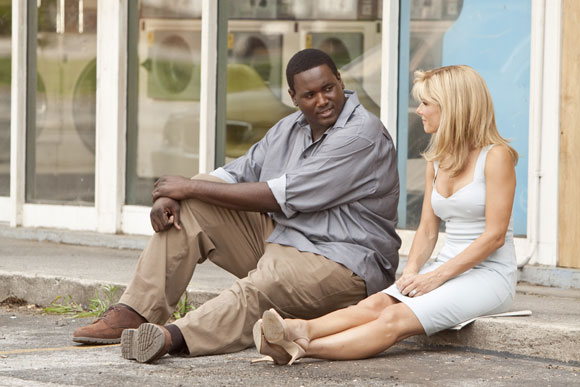The Blind Side

The film begins with the story of NFL quarterback Joe Theismann who suffered a career-ending injury in 1985 when sacked by Lawrence Taylor. While I’m sure there was some message about Taylor to be appreciated there, all I could think of was Theismann’s ended career and what would have happened if he had never become famous. There are aspirations, and then there are pipe dreams. Football superstardom tends to fall into the latter category. While it’s true that this film’s protagonist went on to be drafted by the NFL, the movie has nothing do with his success there.
Michael Oher (Quinton Aaron), known mostly as “Big Mike” due to his hulking size relative to his age, is being questioned by who appears to be a social worker, but turns out to be an investigator for the NCAA. The bookended introduction then rewinds to two years’ prior when, while walking in the rain, Leigh Anne Tuohy (Sandra Bullock) and her husband Sean (Tim McGraw) happen to drive by. The scene may appear to introduce us to the Tuohy’s generosity but mostly drives home Leigh Anne’s ambitious persistence.
The film is perforated with clichés, such as Michael’s disbelief at everything affluence has to offer—beds, for example. Michael is from the projects, not a rainforest in South America. At school, students look at him strangely. By contrast, in the documentary More Than A Game, about five black basketball players who went to a nearly all-white private school, none of them were greeted with strange glances or maliciousness. In fact, they were quickly embraced by classmates, hounded by girls.
The teachers gossip in the break room about Oher’s chances of succeding in class. I’m curious. If he were a white athlete would the characters be given the same lines? Sure, some teachers are certifiably jerks but most of them tend to be genuinely concerned with the success of their students. It seems all the more baffling for these teachers to be employed at Briarcrest Christian, a private prep school. But this is merely a set-up to allow one teacher to deliver a brief “We’re supposed to be good Christians” message.
There are some humorous moments of interplay between Big Mike and the Tuohy’s gregarious son, S.J. (Jae Head), and Sean quipping about Thanksgiving dinner, “Thank your mother for driving to the store and getting this.”
Mostly, however, little character development occurs. We see random bits of Michael’s past, presented as traumatic flashbacks, but instead of establishing a real depth to Michael, these serve as lead-ins to rather implausible confrontation sequences played for kicks and comedy. Leigh Anne Tuohy walks right up to a drug dealer and threatens him to cough up Michael’s whereabouts. Michael beats up a room full of armed gangbangers with his bare hands. Did it happen in real life? Perhaps. Though from experience I can surmise that Hollywood embellished on the details. Even ignoring that, the lighthearted way in which the sequences are shot and acted doesn’t give us a genuine sense of impending danger.
The only scene that rises above this white, surburban, heartstring-tugging melodrama, complete with the ladies’ luncheon with Leigh Anne’s cartoonishly-bigoted friends from whom she walks away in a huff, is a visit to Michael’s biological mother’s house. She’s a drug addict and a prostitute. A somber moment is shared between the two mothers. Quickly, the film abandons social commentary for a parade of NCAA coach cameos in a courtship montage where schools attempt to recruit Michael while negotiating perks with S.J. in some sort of nod to Ben Affleck’s extortion of recruiters in Good Will Hunting.
While The Blind Side wallows in varying degrees of white guilt, it returns to the NCAA investigation into whether or not the Tuohys did everything for Michael to ultimately farm him out to their alma mater, Ole Miss, to which they have made generous contributions. The black kid is the MacGuffin around which revolves the affected lives of white people. Even when pretending to focus on Michael’s heartfelt desire to follow in his parents’ footsteps, the story’s response to the ethics inquiry points to the Tuohy’s generosity as his motivation for honoring them. Wasn’t it their generosity that seeded the moral conundrum to begin with? Intriguingly, the film veered toward controversy, but steered clear of the fact that the real Tuohys also created one of the largest Evangelical churches in Memphis. I sense a theme here, and it’s not altruism.
 The Blind Side • Dolby® Digital surround sound in select theatres • Aspect Ratio: 1.85:1 • Running Time: 128 minutes • MPAA Rating: PG-13 for one scene involving brief violence, drug and sexual references. • Distributed by Warner Bros. Pictures
The Blind Side • Dolby® Digital surround sound in select theatres • Aspect Ratio: 1.85:1 • Running Time: 128 minutes • MPAA Rating: PG-13 for one scene involving brief violence, drug and sexual references. • Distributed by Warner Bros. Pictures